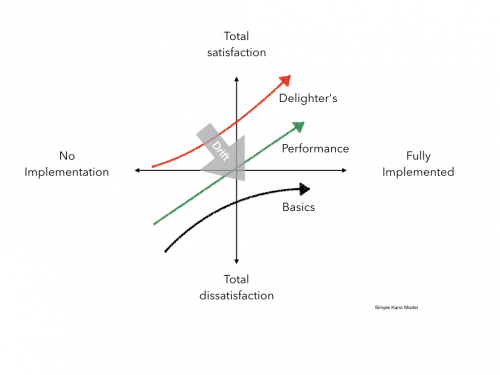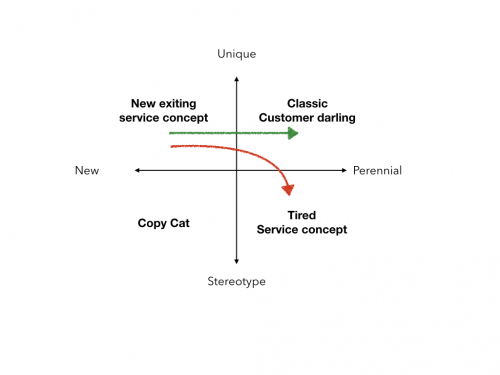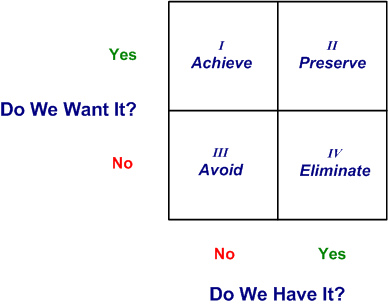I spotted at least 10-15 new restaurants, cafes and other food related concepts on my walk downtown yesterday. I love the raw courage, energy and pure optimism many of these new service ventures exude. They are brave because the reality is that by next summer, most of them will be struggling and many of them will already be gone.
And then once in a while, there is a survivor, a business idea that makes it through that first critical 2-year hurdle and becomes a viable stable business. But that is just the first hurdle, the real test is to make it past the 5-year mark and beyond.
So what does it take?
You need to do two things equally well. On the one hand, you need to be extremely consistent in the way you deliver your product and at the same time, you need to be constantly renewing and innovating. That is the wicked paradox and that is why it is so hard to do.
One way to understand this is to use the Kano model.
 Quickly explained, you could say that our goal is to reach total satisfaction, and avoid any dissatisfaction. In order to reach that goal. I will need to ‘implement something’. Certain things need to be in place.
Quickly explained, you could say that our goal is to reach total satisfaction, and avoid any dissatisfaction. In order to reach that goal. I will need to ‘implement something’. Certain things need to be in place.
If we stay with the simple example of the coffee shop, there are certain basics that need to be in place in order for you as a customer to even consider this a coffee shop. Tables, chairs, coffee, decent hygiene. If these basic are not there and well functioning, you would not even consider setting foot there. But that does not mean that more tables and chairs and scrubbing the floor even cleaner are going to attract even more customers.
It will take something more than just the basics.
You will need to implement attributes that we could call performance items. For a cafe to be considered a possible option for me. it would need to have high-quality coffee, friendly helpful staff, a selection of light bakery items etc..
This, of course, is individual and subjective. Now in my case, I can easily think of a dozen coffee shops that would fulfill these performance criteria. But there are a few coffee shops in town that I will actually go out of my way to visit. Not only do they get the basics right, they also fulfill my performance criteria AND they have something that delights me, a feature that I find unique and special for this place and that few others have in the same way.
But these needs are layers in order of priority. One layer builds on the next. It’s no use focusing on the delighters and neglecting the basics.
So the need for consistency is about the ‘basic’ and especially the ‘performance’ items. If they are not stable, you’ll very soon get tired of a place. If most days the coffee is great but sometimes it’s not, that is the end of that. You find somewhere that is consistent. Because the main reason we come back to a service experience is that we would like more of what we had on the previous visit. This is a fundamental customer need that we must never forget as service providers.
But at the same time, in the Kano model, there is also this notion of ‘drift’. Maybe, 6-7 years ago what really delighted you about a certain cafe was that it had free, no code high-speed internet connection (and it was one of the few that offered this in your area). Then 2-3 years ago, you started thinking of the free high-speed internet as a performance item, most of the good cafes had that. And today you probably consider that internet connection is as basic as the tables and chairs, and if it is slightly inconsistent in its performance, you will switch to a cafe that does have a stable internet connection.
So the service attributes that start out as delights, over time drift and become first performance items and then just basic. The reason for this is that customer expectation mature and competition is constantly copying the best delighters from each other. That puts us under constant pressure to renew ourselves to continuously think up new delighters while skilfully maintaining our performance and basic attributes.
This over time becomes a delicate balancing act. What to add, what to maintain and what to let go. It can only be done successfully by being very ‘close’ to our customers. We need to fully understand why they chose us, and how their preferences are evolving!
 If we are successful doing that, we achieve the nirvana of a great service concept and become perennial. My favourite example of this is the Danish Museum of Modern Art in Louisiana, it has existed for more than 50 years. There are certain things that are rock solid consistent and at the same time, they are always reinventing themselves. Brilliant!
If we are successful doing that, we achieve the nirvana of a great service concept and become perennial. My favourite example of this is the Danish Museum of Modern Art in Louisiana, it has existed for more than 50 years. There are certain things that are rock solid consistent and at the same time, they are always reinventing themselves. Brilliant!
 If you are not familiar with the intricacies of the Service Profit Chain, we have a special treat for you:
If you are not familiar with the intricacies of the Service Profit Chain, we have a special treat for you:
You can download Mike’s book Best! No need to be cheap if … for FREE using this coupon 8WG55DP7C3. This is only available for a limited number of 30 people so first come first serve!

